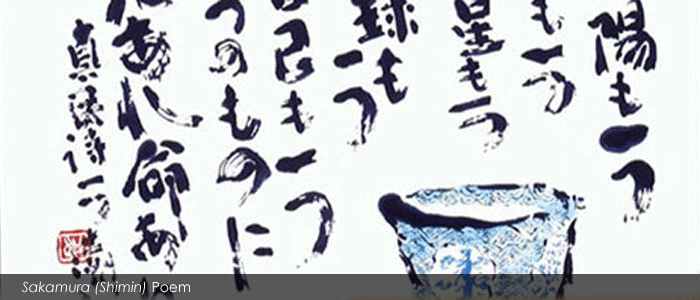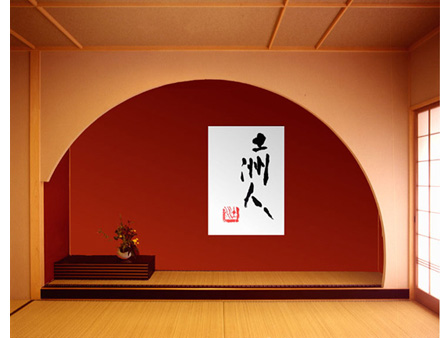

August 29 - September 5, 1998 | Gallery V
694 N. High Street | Columbus, OH 43215 | USA
Didactic text and essays by Mitsuna Kawamura and John C. Huntington.
Timeline
-
1943
- Born in Hamamatsu, Japan
- Elected member of Art & Calligraphy Association of Japan, receiving numerous awards and prizes
- Encouragement award, 'Shizuoka Art Festival
- Exhibitor, 'Tokyo Uenonomori Museum - Japan New Artist Exhibition
- Prize of Excellence, 'Mainichi Calligraphy Exhibition'
- Japan Shogeiin Grand Prix, 'Art & Calligraphy Association of Japan'
- The 15th Nitten Prize, 'The 15th Japan Exhibition of Arts'
- The 17th Nitten Prize, 'The 17th Japan Exhibition of Arts'
- Elected member of Yomiuri Writing Association
- Private Show : Melbourne , Australia
- Exhibitor : 'International Art Show' Paris, France
- Title for TV drama, National Broadcasting Network
- Joint Show with Minoru Shimizu, Hamamatsu
- Title for Japan-China joint TV program, National Broadcasting Network
- Private Show, Daiwa Art Salon
- Private Show, Maruyama Tea Factory
- Private Show, 'Craft Show', Entetsu Department Store
- Private Show, Seibu Gallery
- Yamaha Gallery
- Suzuran Department Store
- Odakyu Department Store
- Daiwa Art Salon
- Maruhiro Department Store
- Enetsu Department Store
1968-1983
1974
1975 & 1976
1979
1982
1983
1985
1988
1989
1993
1995
1996
1997
1986-1998
Introduction

The calligraphy that exists in Japan today originated in China, thus it may also be called 'Chinese Calligraphy.' After reaching Japan, this Chinese Calligraphy became a tradition in Japanese culture. The primary goal was to write beautifully and skillfully, however, like any other form of art, appreciation of beauty was also an aim.
Modern calligraphy in Japan is 'traditional' with its long history, 'disciplined' with strict hierarchism, 'prestigious' with skillful elected members, and 'delicate' with precious materials such as inks and papers dating back to 15 to 20 years to give certain effects. Unfortunately, its dissemination has been very limited, resulting in seeing less calligraphy than painting and sculpture in the world of art.
Looking at a calligraphy as art may be different from how one looks at a painting. Japanese calligraphic tradition examines calligraphy in the following ways: First, one begins by reading the word and, thereby, reflecting on its meanings. Second, one looks at the writing itself to see the structural beauty. So if you can enjoy the meanings of the word or words, as well as their structural beauty, the calligrapher has succeeded. Another way to examine calligraphic art is to begin by reading the word for its meanings, followed by an examination of the writing style to see if the meaning and the style are harmonious. For example, the word 'child' has many meanings, such as pure, unrefined, and wild, in the Japanese context. These meanings should be carried out in the style.
The Japanese way of looking at a calligraphic work have been introduced here. How one see each work, however, is up to the individual, and one also may certainly evaluate calligraphy in the same manner as one evaluates other paintings. However, it is highly recommended that you try these ways as well.
One last, but important, factor should be addressed -- the Japanese letters and characters themselves. There are three types of letters and characters in the Japanese written language, all derived from Chinese characters: kanji, hiragana, katakana. Kanji are Chinese characters in full form, and although some have been simplified, most remain unchanged. It is a combination of meaningful symbols that create different meanings for each and every character. Hiragana, a syllabary similar to the alphabet, has fifty single letters that are derived from kanji. When compared with kanji, hiragana is much more simplified. Katakana, which is a slightly more simplified than hiragana, is used for adopted words from other languages. Katakana is more linear and rigid than the flowing lines of hiragana. All three types of Japanese writing have a 'serif-like' finish, or a fine line finishing off the main strokes of a letter. This is very important to writing structurally beautiful Japanese writing.
Having some understanding for what the world of calligraphy in Japan is like, it is time to introduce someone from this 'traditional,' disciplined,' 'prestigious', 'delicate,' but 'limited' world. Even thought he is renowned for his calligraphy, he turned to the world of art and its diversity. He has taken one of Japan's oldest forms of art and imbued it with his own unique view of our nature. It is an honor to introduce to you -- Doshu Kanayama who combined the world of calligraphy and the world of fine art in search for a new form of art.
Doshu Kanayama
Born in the city of Hamamatsu, Japan, Doshu Kanayama began the customary training in calligraphy at a young age. "My brother was much better at it," recalls Kanayama. "I was never good at copying the text. Then one day, I realized that I was writing in a style that nobody else had." In 1973 he was elected a member of the honored "Art and Calligraphy Association of Japan." As Kanayama progressed, he received numerous awards and prizes for renowned exhibitions, such as the prestigious Nitten Prize (Japan Exhibition of Arts).
In 1986, he left 'Chuohshodan,' an association for the field of calligraphy, and embarked on a new direction. His mind was set to work in the manner that the words would rejoice the life of the individuals. Hence, meaningful works were naturally created. His works maintain a Japanese flavor, since he continues to work with rice paper, hanging scrolls, screens, kimonos, obi belts, and other traditional images/medium.
Especially inspired by the surrounding warmth of life, nature, and mankind, his works enrapture many of those who come to see his shows. "I think people with more character are more interesting than [those] that are just plain beautiful. And the same theory applies to my works. The writings with character are better than beautiful writings," says part-time calligraphy teacher Kanayama. "The children amaze me. They are so honest in expressing their feelings in writing."
Doshu Kanayama, a prominent calligrapher, continues to communicate his inspirations to the world.
Special thanks goes to Norio Kawamura and Ms. Guey Liaw for their initiative and efforts and to Doshu Kanayama for making public his inspiring works.
The gallery exhibition is co-sponsored by Honda of America, Mfg., Inc. and Columbus Council of World Affairs.
